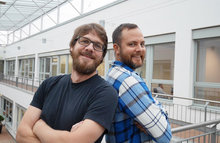Neuherberg, 06.09.2018
Extensive insights into metabolism – the orchestra in the body
A recent paper published in the scientific journal Cell gives an unprecedented insight into the metabolic interactions that occur throughout the body over 24 hours. As part of a large-scale study, the authors constructed 24-hour metabolic profiles of mouse tissues and organs under conditions of energy balance and high-fat diet. Their findings provide an overview of how the various metabolic pathways in the body are interconnected and also reveal suitable time frames for anti-obesity therapies. The study was conducted under the aegis of the Helmholtz Zentrum München and the University of California Irvine in collaboration with the German Center for Diabetes Research (DZD).
Metabolic processes take place constantly throughout the body. Food is broken down into small pieces, tissue is regenerated and waste products excreted. But none of these processes occurs in an uncontrolled manner. In order to prevent interactions between the various processes from descending into chaos, all the processes are regulated by circadian (24-hour) rhythms.
“You can think of it as in an orchestra,” explains Dr. Dominik Lutter, group leader at the Institute for Diabetes and Obesity (IDO) at the Helmholtz Zentrum München. “If you want to create a harmonious sound, the individual instruments can’t just start playing at random: they have to play in time. It’s exactly the same principle with metabolism, where the beat is dictated by the circadian rhythm.”
To shed light on this interaction, the scientists generated 24 hour metabolic profiles of eight different tissues simultaneously. These included the suprachiasmatic nucleus in the hypothalamus (regarded as the principal circadian pacemaker in mammals), in addition to prefrontal cortex, skeletal muscle, liver, brown and white adipose tissue, blood and sperm.
“To understand how diet impacts tissue synchronization and 24 hour metabolism we compared all this data under normal and high-fat diets,” adds IDO scientist Dr. Kenneth Dyar, first author of the study along with Dominik Lutter. “High-fat food is known to disrupt circadian rhythms and cause metabolic diseases like obesity and diabetes. This temporal view of tissue metabolism gives us better insight into how metabolism is changed in metabolic diseases, for example, in the case of obesity and diabetes.”
Excess calories from fat upset metabolic rhythms
The researchers were also able to observe how high-fat food consumption disrupts tissue metabolism. “In muscle tissue, for instance, we noticed that energy generation from fat and sugar occurred separately and in a very orderly sequence under conditions of energy balance,” Kenneth Dyar explains. “However, under high fat diet, this typical pattern broke down completely and fat metabolism dominated. These changes have major implications for how diet can contribute to development of muscle insulin resistance.”
Overall, the study provides an overview of the metabolic processes taking place in the respective tissue at any given time, and also reveals previously unknown links. From that, the authors say, one can also deduce the most promising time frames for administering metabolically effective medication. “To come back to the image of an orchestra, we now have an initial score of the metabolism in our hand, and we understand the delicate interplay between the instruments,” Dominik Lutter says in conclusion. “What we want to do next is learn how to make everyone in the orchestra play in unison if they are out of tune.”
The study was supervised by Professor Paolo Sassone-Corsi (University of California, Irvine), Dr. Kristin Eckel-Mahan (University of Texas Health Science Center at Houston) as well as by Professor Jerzy Adamski and Professor Matthias Tschöp from the Helmholtz Zentrum München. In August 2018, Professor Tschöp was appointed CEO of the Helmholtz Zentrum München.
Further information
Original publication:
Dyar, KA. et al. (2018): Atlas of Circadian Metabolism Reveals System-wide Coordination and Communication between Clocks. Cell, DOI: 10.1016/j.cell.2018.08.042
As German Research Center for Environmental Health, Helmholtz Zentrum München pursues the goal of developing personalized medical approaches for the prevention and therapy of major common diseases such as diabetes mellitus, allergies and lung diseases. To achieve this, it investigates the interaction of genetics, environmental factors and lifestyle. The Helmholtz Zentrum München has about 2,300 staff members and is headquartered in Neuherberg in the north of Munich. Helmholtz Zentrum München is a member of the Helmholtz Association, a community of 18 scientific-technical and medical-biological research centers with a total of about 37,000 staff members.
The Institute of Diabetes and Obesity (IDO) studies the diseases of the metabolic syndrome by means of systems biological and translational approaches on the basis of cellular systems, genetically modified mouse models and clinical intervention studies. It seeks to discover new signaling pathways in order to develop innovative therapeutic approaches for the personalized prevention and treatment of obesity, diabetes and their concomitant diseases. IDO is part of the Helmholtz Diabetes Center (HDC).
The German Center for Diabetes Research (DZD) is a national association that brings together experts in the field of diabetes research and combines basic research, translational research, epidemiology and clinical applications. The aim is to develop novel strategies for personalized prevention and treatment of diabetes. Members are Helmholtz Zentrum München – German Research Center for Environmental Health, the German Diabetes Center in Düsseldorf, the German Institute of Human Nutrition in Potsdam-Rehbrücke, the Paul Langerhans Institute Dresden of the Helmholtz Zentrum München at the University Medical Center Carl Gustav Carus of the TU Dresden and the Institute for Diabetes Research and Metabolic Diseases of the Helmholtz Zentrum München at the Eberhard-Karls-University of Tuebingen together with associated partners at the Universities in Heidelberg, Cologne, Leipzig, Lübeck and Munich.
Press contact

Birgit Niesing
niesing(at)dzd-ev.de
+49 (0)89 3187-3971
 |
